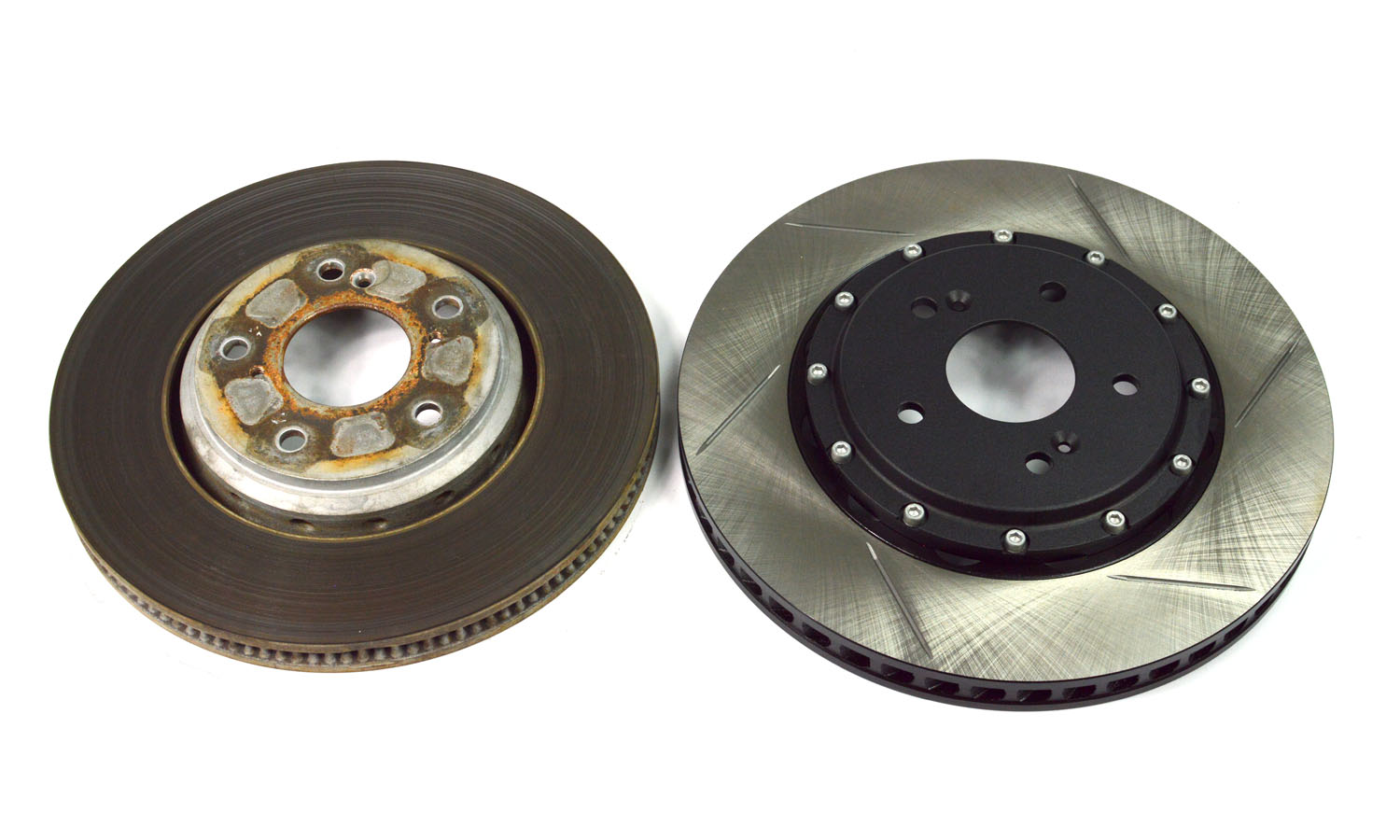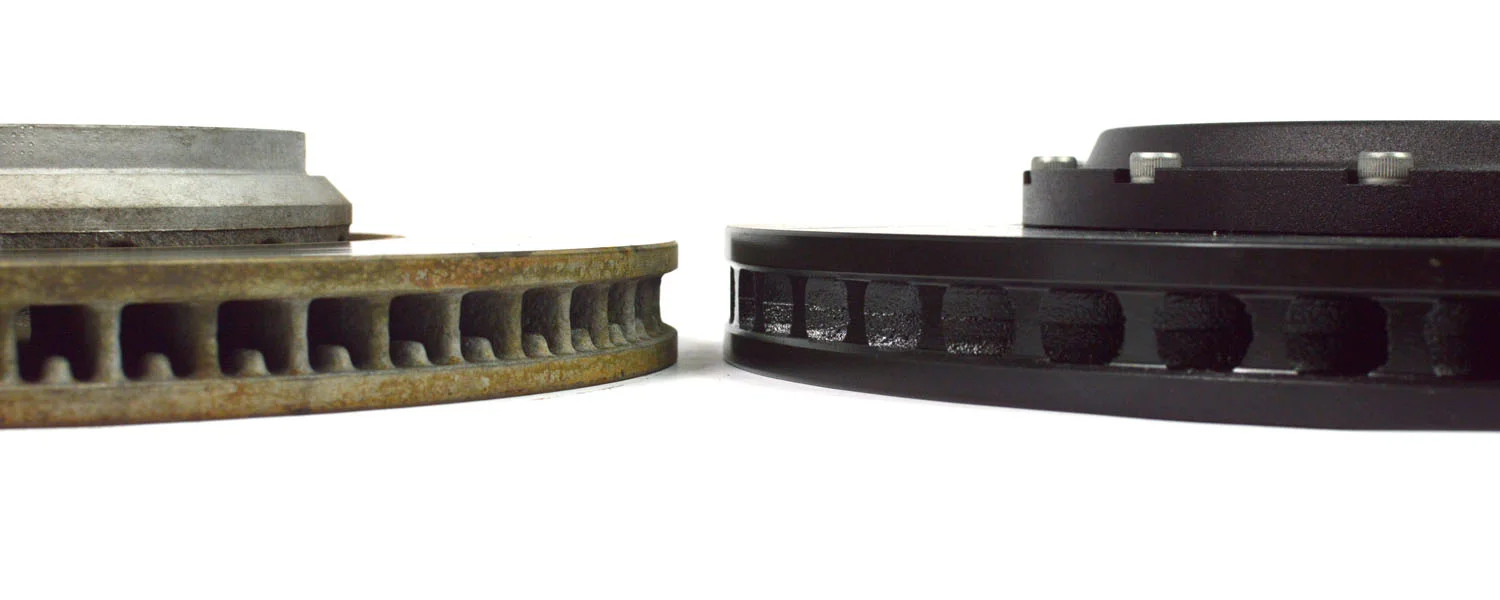Big Brake Kit for the Honda Civic – Part 1
A few weeks ago we brought up the topic of brakes for the FK7 (Hatchback Sport) and FC1 (SI Sedan). Having been severely disappointed with the OEM FK7 front brake package we sought out to see if the FC1 front brakes were a better setup and if they could be installed on the FK7 for a small upgrade. Unfortunately, not only was the FC1 brake setup not good enough for us but it also was not a simple bolt-on upgrade for the FK7 as we had hoped for.
So we took matters into our own hands and developed a solution. "mic drop"
In this blog we are going to do a static comparison of the OE brake package and the 27WON Performance Big Brake Kit (BBK) for the Honda Civic SI. We will compare weights and sizes and then go a bit into why you should care about these things.
Comparing OE to 27WON, you can see the design is drastically different.
The conventional OE style uses a single piston sliding caliper. It’s cost effective for Honda and provides exceptional wheel clearance. This is great for the grocery getter but when used in a performance application the OE style caliper can quickly be overwhelmed.
The 27WON BBK utilizes a 2-piece opposing piston design that is commonly found in high-performance applications. Aluminum forgings are used for superior strength and low weight then combined with four stainless steel pistons for reduced thermal conductivity.
Speaking of weight…let’s breakdown some numbers:
OE SI Brake Caliper: (this includes the caliper, brake pads, mounting hardware, and brake line)
---6.91 kg (15.24 lbs)
27WON BBK Caliper: (this includes the caliper, brake pads, mounting hardware, and brake line)
---5.37 kg (11.84 lbs) - Decrease of 1.54 kg (3.4 lbs) or 22%
That is a significant weight reduction of unsprung mass and remember that is per corner! But why does this matter?
There are two main ways of categorizing mass on the car. There is sprung mass and unsprung mass. Sprung mass is everything that is supported by the front and rear suspension of the car. This is everything like the engine, transmission, driver, body, etc. Unsprung mass is just the opposite. Those components that are not supported by the springs. This includes parts like the tires, wheels, and you guessed it brakes.
By reducing unsprung mass we are able to improve handling. The lower the unsprung mass is the less work the springs and shocks have to perform in order to keep our tires firmly planted to the ground and ultimately it's that contact patch of tire that allows our car to do anything useful at all. Basic physics here, more weight means higher inertia. Higher inertia means more workload for our suspension to perform. Reducing the weight reduces the work required of our suspension and in turn, gives us improved handling and vehicle stability.
Now let's look at the rotors.
Again we see a significant difference when comparing OE and the 27WON BBK. The OE rotor is a standard 1-piece design; this means the rotor ring and rotor hat are cast as one piece. However, unlike the OE caliper, Honda has done some extra R&D here to help braking performance. Short secondary rotor vanes are set on the inside surface of the rotor shown in the above image and ventilation holes were added to the rotor hat shown in the last image below. It seems obvious that Honda was trying to remove extra heat.
The 27WON BBK takes a different approach to braking performance. First, a 2-piece design is utilized for reduced weight. It does this by allowing us to utilize different materials for both the rotor hat and the rotor ring. Choosing to use an aluminum alloy versus cast iron for our rotor hat helps reduce weight and again unsprung mass. Second, the rotor thickness is increased 3mm. This increases the thermal capacity of the rotor which allows us to regulate brake temperature better. Lastly, there is a fine detail that some might miss completely; the rotor vanes are directional. Swept direction vanes improve the cooling performance of the rotor compared to straight vanes and therefore can withstand greater heat spikes and increased heat duration periods.
So lets recap on some of the Civic 2016+ brake data from the breakdown blog and see how the numbers stack up.
SI
1-piece rotor design
310mm outer diameter
25mm pad thickness
60mm pad engagement surface
7.750 kg (17.08lbs)
HBS
1-piece rotor design
280mm outer diameter
23mm pad thickness
55mm pad engagement surface
5.960 kg (12.33 lbs)
27WON Big Brake Kit
2-piece rotor design with AL rotor hat
330mm outer diameter
28mm pad thickness
55mm pad engagement surface
7.93kg (17.48lbs)
Now while you don't see a weight reduction from the rotors what we did accomplish is the ability improve the thermal capacity of the system (and therefore the braking performance) of the rotor with just a very small penalty in weight. That's an acceptable sacrifice for brakes that drastically outperform the OEM unit.
Like every 27WON Performance part for you 10th Generation Civic, the Big Brake Kit is a complete kit. Calipers, rotors, mounting brackets, hardware, and stainless steel braided brake lines. Check in later as we break down the 27WON BBK further and dive into the results of our track testing.
Thanks for tuning in with 27WON Performance.
I DARE YOU TO REDEFINE THE AFTERMARKET
-Barett






